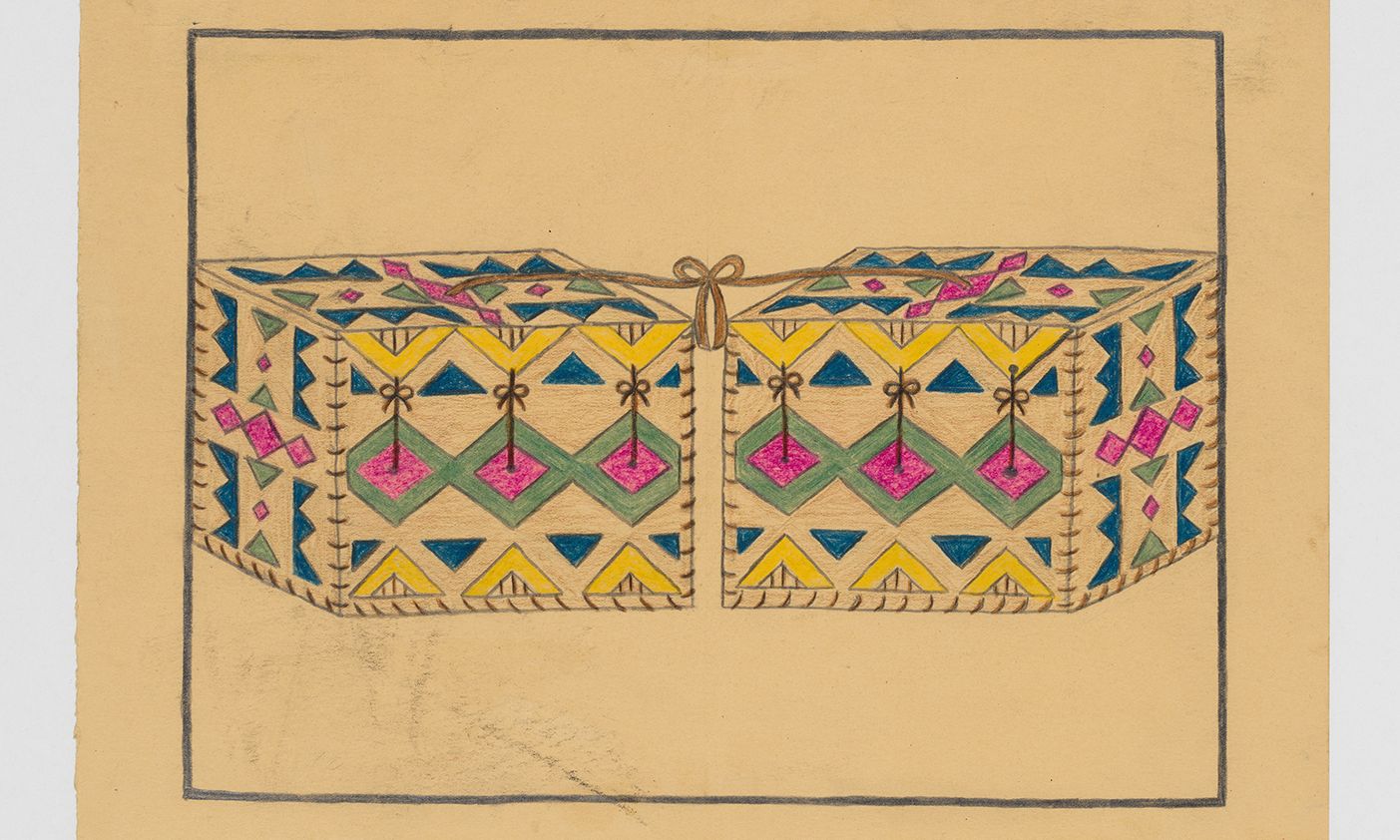Detail from Lunt & Fontanne (Alfred Lunt, 1892-1977, and Lynn Louise Fontanne, 1887-1983) (around 1920s-40s), one of Mary Sully’s “personality prints”
Morris K
Metropolitan Museum of Art, until 12 January 2025
The Met hosts the first solo show of drawings by the late Yankton Dakota artist Mary Sully (1896-1963), who combined traditional aesthetics of the Dakota and other Indigenous groups with the Art Nouveau style and popular culture of her time. Largely unknown until the 21st century, Sully is now celebrated for her “personality prints”: abstract triptych portraits of people like Fiorello La Guardia, Babe Ruth and Gertrude Stein. Sully was born on the Standing Rock Reservation in South Dakota and had a complex family history. Her mother, Susan Pehandutawin, was also an artist, as was her great-grandfather—the painter Thomas Sully, who created the 1824 portrait of Andrew Jackson that has been used for the $20 bill since 1928. Her grandfather, Alfred Sully, was a military officer who fought in several wars against Native Americans. Together with her sister, the anthropologist Ella Deloria, Mary Sully travelled throughout the US, taking inspiration for her own work from the arts of the many Native American groups they visited.
Elena Goukassian
Installation view of Projects: Tadáskía, the Brazilian artist’s first solo show in the US
Photo: Jonathan Dorado, © MoMA
Museum of Modern Art, until 14 October
The centrepiece of this exhibition by the mononymic Brazilian artist Tadáskía is ave preta mística mystical black bird (2022), an unbound book consisting of 61 drawings and texts in English and Portuguese that chronicle the titular bird’s journey of discovery and transformation. The Museum of Modern Art acquired the work earlier this year and, for this exhibition (co-organised by the Studio Museum in Harlem), the artist created kaleidoscopic murals and sculptural installations to accompany and amplify ave preta mística’s fantastical imagery.
The exhibition marks Tadáskía’s first solo show in the US and comes after a breakout showing at last year’s Bienal de São Paulo, where a similarly dazzling installation pairing site-responsive murals and sculptures with works on paper made a strong impression. “This special collaboration is a remarkable opportunity to champion an emerging voice in contemporary art and furthers the Studio Museum’s commitment to artists of African descent globally,” says Thelma Golden, the Studio Museum’s director and chief curator.
Benjamin Sutton
Profile of a Man in Striped Shirt (undated) by Frank Walter, the late Antiguan artist and polymath
Photo: Kenneth Milton; courtesy of Barbara Paca
The Drawing Center, until 15 September
For the late Antiguan artist Frank Walter’s (1926-2009) first solo exhibition in the US, The Drawing Center brought together a selection of the polymath’s wide range of creative output. In his lifetime, Walter created thousands of paintings, drawings, sculptures, photographs and audio recordings delving into the history and politics of the Caribbean and incorporating the topics of slavery, colonialism, and race and identity. Walter had a complicated relationship to his own identity as a descendant of both enslaved people and plantation owners, which was made more fraught after he became the first person of colour to manage an Antiguan sugar plantation. This was further compounded by his later encounters with structural racism when he moved to Europe for several years in the 1950s. In addition to his visual art, Walter was an avid writer, leaving behind a 50,000-page archive of poetry, stories, genealogical trees, maps and even musical scores. The title of the exhibition comes from someone witnessing the artist at work: “With only a few lines,” one acquaintance observed, “he would capture your soul.”
E.G.
FUTURA 2000’s Garbage Rock (1983); the show at The Bronx Museum explores the artist’s work since the 1970s
Collection of Patrick Lerouge
The Bronx Museum, 8 September-30 March 2025
A fixture of New York City’s graffiti scene in the 1970s, Leonard Hilton McGurr—better known as FUTURA 2000—set himself apart in 1980 with his infamous Break painting, an Abstract, neon-hued composition across an entire subway car that made it look as if a giant hole had been punched through the side of the train. Since then, he has been one of the most enduring and inventive artists to cross over from graffiti into the gallery world. This retrospective, FUTURA 2000’s most comprehensive to date in his hometown, brings together paintings, archival materials, prints, drawings, sculptures, studies, site-specific installations and more. It will span his early street-based works and science-fiction inflected paintings of the 1980s and 1990s to his more recent graphic and abstract compositions, showcasing the graffiti pioneer’s enormous range. “FUTURA 2000’s unique visual language—bridging street art, Abstract Expressionism and fashion—places him alongside his peers like Jean-Michel Basquiat within the canon of art history,” says Klaudio Rodriguez, the museum’s executive director.
B.S.

